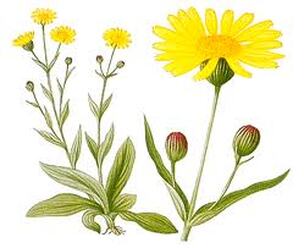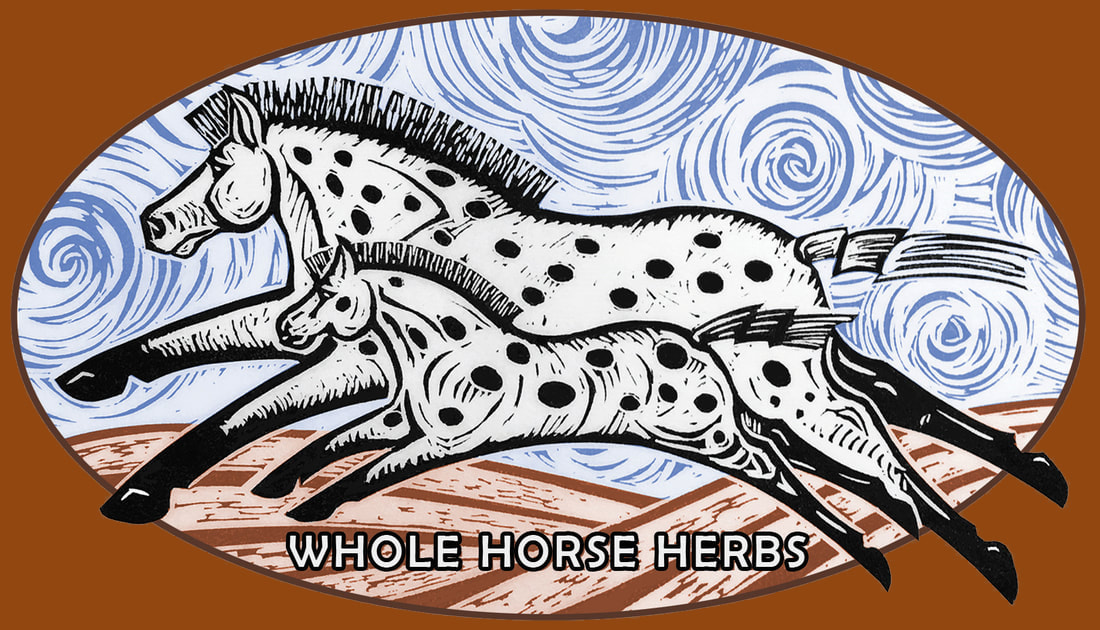Equine Pain Relief
Amazing Arnica
Natural First Aid for Horse and Rider
 Arnica, an excellent remedy for pain relief
Arnica, an excellent remedy for pain relief
By Gloria Garland L.Ac, Dipl. Ac. & CH.
Kicks, bites, and injuries are an inevitable part of horse ownership. Arnica is one of the top “must have” herbs in any herbal first aid kit and makes dealing with these unavoidable events easier.
Arnica, a small, daisy-like yellow flower is known by several common names including mountain tobacco, wolfsbane and leopardsbane. Arnica montana is the variety most commonly used in America and in commercial preparations.
Arnica has long been used medicinally in America and Europe for injuries and traumas of all sorts, from shock to fractures. It is a favorite herbal remedy of Queen Elizabeth of England, and it is easy to understand why. Arnica significantly reduces inflammation, prevents bruising and speeds healing. Certainly, arnica is a handy remedy to have in any stable!
Arnica’s amazing abilities are attributed to the potent anti-inflammatory chemical helenalin. Helenalin belongs to a group of plant-based compounds called sesquiterpene lactones. Sesquiterpene lactones are also found in salad greens like spinach, lettuce and chard. They are what give dark, leafy greens that slightly bitter flavor.
Scientists are not exactly certain how sesquiterpene lactones, like helenalin, actually function in the body. This group of compounds is the focus of on going study and research. However, researchers agree that the helenalin contained in arnica enables the healing process. Helenalin facilitates the transport of blood and fluids away from the point of injury and the removal of damaged tissue debris by stimulating and dilating blood vessels. The result is less inflammation and reduced bruising and pain.
Arnica and its uses in the stable
Arnica excels in the treatment of bruises of all types. Just rub it on the affected area. For bruised soles add arnica tincture to your soaking bucket or soak paper towels with arnica liniment for use inside hoof boots. Tendon strains also respond well to arnica soaked paper towels applied under wraps. Topical applications of arnica cool down hot, laminitic feet and soothe arthritic joints. Diluted with water, arnica makes a revitalizing bath after workouts or long trail rides.
A note of caution: Never give your horse arnica tincture by mouth. Arnica should only be taken orally as a homeopathic remedy. Use arnica topically in liniment or ointment form and avoid direct contact with open wounds. Many excellent arnica preparations are commercially available from natural and health food stores. It is available as lotions, liniments, gels and ointments. I prefer to make a liniment with dried arnica flowers. It is economical and very easy to do. Simply fill a large glass jar with four cups of either which hazel, rice wine or vodka and add 1/2 cup of dried arnica flowers. Cover with a lid and store in a cool, dark place for at least two weeks. Shake the jar daily. The result will be a rich, dark amber liquid. If kept sealed, it will last for several years. I like to keep a small spray bottle filled with arnica liniment on hand in my barn for easy applications.
See Whole Horse Herbs Liniments and First Aid
Amazing Arnica - Natural First Aid for Horse and Rider Download Printable PDF
Herbs for horses educational series # 2
Equine Herbs educational series # 1
Kicks, bites, and injuries are an inevitable part of horse ownership. Arnica is one of the top “must have” herbs in any herbal first aid kit and makes dealing with these unavoidable events easier.
Arnica, a small, daisy-like yellow flower is known by several common names including mountain tobacco, wolfsbane and leopardsbane. Arnica montana is the variety most commonly used in America and in commercial preparations.
Arnica has long been used medicinally in America and Europe for injuries and traumas of all sorts, from shock to fractures. It is a favorite herbal remedy of Queen Elizabeth of England, and it is easy to understand why. Arnica significantly reduces inflammation, prevents bruising and speeds healing. Certainly, arnica is a handy remedy to have in any stable!
Arnica’s amazing abilities are attributed to the potent anti-inflammatory chemical helenalin. Helenalin belongs to a group of plant-based compounds called sesquiterpene lactones. Sesquiterpene lactones are also found in salad greens like spinach, lettuce and chard. They are what give dark, leafy greens that slightly bitter flavor.
Scientists are not exactly certain how sesquiterpene lactones, like helenalin, actually function in the body. This group of compounds is the focus of on going study and research. However, researchers agree that the helenalin contained in arnica enables the healing process. Helenalin facilitates the transport of blood and fluids away from the point of injury and the removal of damaged tissue debris by stimulating and dilating blood vessels. The result is less inflammation and reduced bruising and pain.
Arnica and its uses in the stable
Arnica excels in the treatment of bruises of all types. Just rub it on the affected area. For bruised soles add arnica tincture to your soaking bucket or soak paper towels with arnica liniment for use inside hoof boots. Tendon strains also respond well to arnica soaked paper towels applied under wraps. Topical applications of arnica cool down hot, laminitic feet and soothe arthritic joints. Diluted with water, arnica makes a revitalizing bath after workouts or long trail rides.
A note of caution: Never give your horse arnica tincture by mouth. Arnica should only be taken orally as a homeopathic remedy. Use arnica topically in liniment or ointment form and avoid direct contact with open wounds. Many excellent arnica preparations are commercially available from natural and health food stores. It is available as lotions, liniments, gels and ointments. I prefer to make a liniment with dried arnica flowers. It is economical and very easy to do. Simply fill a large glass jar with four cups of either which hazel, rice wine or vodka and add 1/2 cup of dried arnica flowers. Cover with a lid and store in a cool, dark place for at least two weeks. Shake the jar daily. The result will be a rich, dark amber liquid. If kept sealed, it will last for several years. I like to keep a small spray bottle filled with arnica liniment on hand in my barn for easy applications.
See Whole Horse Herbs Liniments and First Aid
Amazing Arnica - Natural First Aid for Horse and Rider Download Printable PDF
Herbs for horses educational series # 2
Equine Herbs educational series # 1


